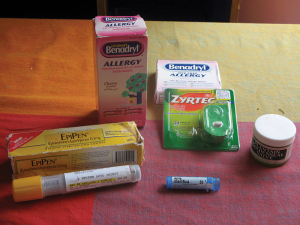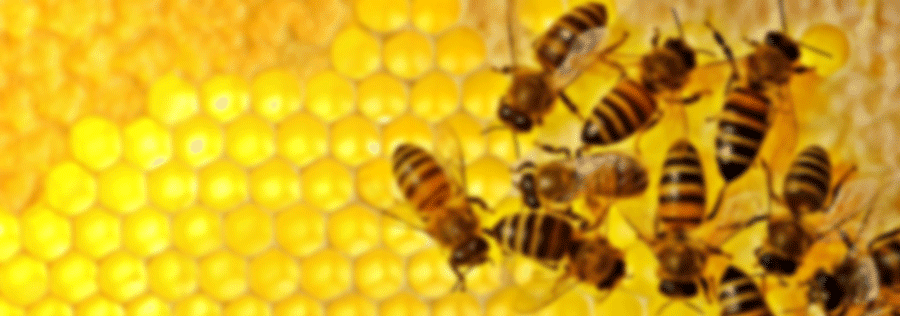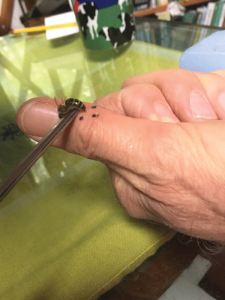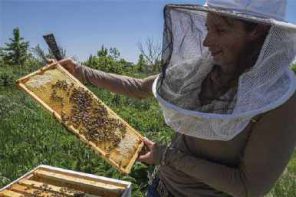If modern medicine is unable to help you, try Bee Venom Therapy (BVT)…you have little to lose.
The use of honey bee products for healing and health (known as Apitherapy) has been in use since ancient times, however, the most attention grabbing apitherapy treatment today tends to be the use of bee stings to reduce disease symptoms. The use of BVT for rheumatic diseases has been recognized for at least 2500 years. (Broadman 1962) While the majority of therapeutically applied bee venom is through injection in the form of desensitization shots for people suffering from hyper-allergic reactions to honey bee venom (anaphylaxis), anyone with access to a hive can obtain venom from the self-contained, self-sterilizing, self-injecting bee venom applicators living within.
An evolving experimental treatment
While bee venom injections are not yet approved by the medical establishment for use treating rheumatic diseases, the sting from the live bee is often used and found helpful for this purpose. Treatment typically consists of applications of bee stings three times a week, about every other day. Treatments are applied over the body on a rotating basis so that a former treatment area is not treated again until all symptoms of the previous stings have healed. This form of BVT is available almost anywhere and, as long as the patient is not hyper-allergic, the treatment is safe without long-term adverse effects even with long-term application of therapeutic doses.
No one has worked as long or as hard to promote the benefits of BVT as Charles Mraz who is recognized the dean of the therapeutic use of bee venom in the United States. Not only did Mraz initiate clinical research in conjunction with the scientists at Sloan-Kettering and the Walter Reed Army Institutes, he developed the USDA purity standard for dried whole venom and supplied venom to pharmaceutical companies worldwide. He went on to become a co-founder of the American Apitherapy Society (AAS): a clearing house for information on apitherapy, which to this day dedicates itself to carrying on Mraz’s legacy by educating the public and health care community about the traditional, clinical and scientifically proven uses of apitherapy.
Rheumatic Disease
While no medical treatment works on everyone 100 percent of the time, most forms of rheumatic disease seem to respond to BVT including gout, osteoarthritis, bursitis, tendinitis, fibromyalgia, lupus, and scleroderma. However, the use of BVT for treatment of rheumatoid arthritis is the area most widely documented (Kwon 2001, Kang 2002, Lee 2004, Park 2004, Yin 2005, Hong 2005). The only cases that do not respond well are where the joints have deteriorated to the extent that there is bone-to-bone contact within the joint and where the bones have deteriorated. While BVT can help with some of the pain symptoms of rheumatic disease, bee venom cannot stimulate the growth of new bone and cartilage.
Although the use of BVT has proven to be clinically valuable in the treatment of chronic pain symptoms research into this area of BVT continues to evolve (Lee 2008). There is also significant research indicating the BVT may help in cases of malignant melanoma, basil cell carcinoma, lymphoma, breast and prostate cancer (Liu 2002, Son 2007, Liu 2008, Park 2011, Oršolić 2012, Mao 2017). BVT also has the potential to help reduce negative reactions to chemotherapy (Al-Atiyyat and Obaid 2017)
BVT has been associated with increased fertility in sterile women and curing miscarriages, but also with increased risk of miscarriage in newly pregnant women. Additional conditions that have been successfully treated with bee venom include; multiple sclerosis, post herpetic neuralgia (shingles), chronic pain syndromes, eczema, psoriasis, sclerosis, corns, warts (including planters warts), Epstein Barr virus (EBV), Lyme Disease, mononucleosis, premenstrual syndrome, menstrual cramps, irregular periods, mood swings, depression, and hypoglycemia.
Bee Venom Collection

Bees are stored in a jar with honey covered by a single layer of paper towel. The towel absorbs the honey and the bees can suck it up while standing on the towel and avoid drowning in the honey. Note a toilet paper core is included to provide a clustering place for the bees and has been cut on both ends to help prevent it from rolling around inside the jar.
Significant amounts of honey bee venom are required by the pharmaceutical industry. In order to provide them with the raw material they need to produce desensitization shots for those who are allergic, beekeepers collect and purify the venom. One way this is done is with a frame embedded with wires that are hooked up to a battery. Under the wire grid is a plastic sheet covered with a rubber membrane. The venom collector is placed up against the entrance to a hive and the hive is kicked in order to elicit a defensive response. When the bees come out, land on the collector and touch any two wires, they get a hot foot and sting the rubber membrane beneath the wires depositing their venom beneath the rubber. The venom that is collected is then dried, filtered and purified in an autoclave before being shipped.
Apitherapists avoid all the work involved in collecting bee venom by using live honey bees. Charles Mraz would re-use an old mayonnaise jar with holes punched in the lid for air to collect and store bees for BVT. Before collecting the bees, a tablespoon of honey is placed on the bottom of the jar and a piece of paper towel, large enough to just cover the bottom of the jar, is placed over the honey. This prevents the bees from wallowing in and potentially drowning in the honey. Charles also would place an empty toilet paper roll in the jar to provide a place for the bees to cluster.
Once the jar is prepared, collecting the bees was as easy as going out to a hive and rattling the jar over an upper entrance in order to stimulate the guard bees to come out and defend the hive. When the desired number of bees is in the jar, it is simply slid across to the edge of the hive and the lid placed on the jar.
Honey Bee Storage
Once the bees are collected, it is best to store them in a dark, quiet place for a while. If necessary, I wrap a dark cloth around the jar to prevent the bees from racing around and around the jar using up their life energy trying to get to the light they see through the glass. This also encourages the bees to quiet down and cluster making them much easier to grab them when the time comes to remove them.
If the bees are to be used for BVT shortly after they have been collected and they are energetically running around the inside of the jar, the container can be placed in the refrigerator for a few minutes. The cold greatly decreases the activity level of the bees making them much easier to catch. Care must be taken not to leave the bees in the cold too long or they will enter a state of torpor where they allow their body temperature to get very low in order to conserve energy. Bees in the torpor state will not readily sting when prompted and must be warmed back up before being used for BVT.
Choosing the sting site
Charles Mraz developed a technique for choosing a sting site by pressing firmly along the joints and bones looking for spots that were sensitive and painful when pressed. He called these “hot spots” and would mark them with a pen or marker whenever they were discovered. This provided a bull’s-eye target for the actual sting. Interestingly, these “hot spots” often coincided with the body’s meridians—the places that acupuncturists insert their needles. Stings applied to these meridian points give greater results than when applied in other areas. (Lee 2005) Some even hypothesize that the honey bee was the first acupuncture needle ever used.
Applying Stings
To help reduce the initial pain of the sting, extreme cold is applied to the ink mark area through the application of ice wrapped in a damp cloth or an ice-pack. The ice is applied for a minute or two in order to numb the sting site and reduce the initial pain associated with the sting.
Once the area is adequately numbed with ice, a bee is removed from the jar and the tip of the bee’s abdomen is applied to the ink mark. Eight to 12-inch forceps are the perfect tool for removing bees from the jar. It is important to try and grasp the bees by their head or thorax rather than the abdomen, since grabbing the bee by the abdomen may damage the stinging apparatus preventing the stinging mechanism from working.
If a person has not received a bee sting within the past two weeks, it is prudent to try a test sting before applying full stings to be sure they have not become hyper-allergic. To apply a test sting simply scratch out the honey bee stinger within a split second after it has become imbedded in the skin. Then wait for 15-20 minutes and monitor the patient. If they do not experience symptoms associated with anaphylaxis, such as fainting, loss of blood pressure, and breaking out in hives all over the body, then BVT can proceed with full strength stings.
How BVT Works
The primary purpose of BVT is to stimulate the body’s immune system so that it can begin to heal itself. Once the stinger is imbedded in the skin, it pumps venom into the sting site. In reaction to the foreign substance entering its system, the body sends large amounts of blood to the area. This concentrates the healing properties within the blood around the sting site. In order to receive a full dose of venom, the stinger is left in the skin for at least 10-15 minutes. During this time the stinger is acting as an acupuncture needle as mentioned above.
The impact of the BVT treatment goes much further however. Dr. Artemov of Gorky University was among the first to prove that the bodies adrenal glands are stimulated by venom to release cortisol. Cortisol is the natural version of the steroid, Cortisone that is commonly used by physicians to treat arthritis and other cases of inflammation. While it is close, Cortisone is chemically not exactly the same as the Cortisol that the body produces and over time patients can develop liver toxicity from Cortisone treatment. It is believed that the body requires various B vitamins and vitamin C in order to produce Cortisol. Thus it is recommended that for best results, people obtaining bee stings for therapeutic reasons take 1,000 to 2,000 milligrams of vitamin C and a tablet containing multiple B vitamins about one hour prior to receiving BVT.

Items that you may want to have on hand when giving, or receiving, bee venom therapy. Unless side effects of stings become unbearable, only herbal salves and the homeopathic remedy, Apis Mellifica, should be used as they will not suppress the bodies immune response while they reduce the bodies reaction to the sting.
Side Effects
As with any treatment, there are side effects that can be expected from BVT treatment. While not everyone will experience all of the possible side effects, the most common side effects include the initial pain of the sting, as well as swelling, redness, itching, soreness and tenderness, feelings of heat in the treatment area, and in extreme cases nausea and fever. It is important to note that none of these localized reactions are typically life threatening. A life threatening anaphylaxis reaction will affect the entire body.
The public’s usual response to a sting reaction is to take an antihistamine. Liquid antihistamines sold for children will be absorbed by the body the quickest providing the fastest relief. A more powerful antihistamine is sold under the brand name, Zyrtec, and used to only be available by prescription but now can be purchased over-the-counter.
The problem with taking antihistamines for uncomfortable reactions to BVT is that they suppress the body’s immune system. Since BVT is practiced in order to stimulate the body’s immune response, drugs that depress the body’s immune system are contraindicated. It is preferable therefore to use the homeopathic remedy, Apis Mellifica, should the side effects of BVT become too uncomfortable, since the remedy can reduce symptoms without suppressing the immune system. Similarly, one should avoid the use of alcohol during bee venom therapy, since alcohol also suppresses the body’s immune system.
Although it is extremely rare, about one percent of the population is hyper-allergic to honey bee venom and will experience anaphylaxis. For this reason, it is prudent to always have an epinephrine injector (brand name: EpiPen) on hand when giving or receiving BVT and always apply a test sting first if the person has not been stung within the past two weeks.
American Apitherapy Society
As a benefit of being a member of the American Apitherapy Society, the AAS will provide you with a free prescription for an epinephrine injector if you need one. The AAS also provides members access to a list of AAS members who reside throughout America and around the world. This apitherapy network can provide information and assistance with most all aspects of apitherapy. This includes everything from where to source honey bees, to being able to post questions on the AAS forum that experienced apitherapists will answer. Questions can include anything from what type of apitherapy is recommended for certain conditions, to what protocols one should follow when treating specific conditions and what results other apitherapists have experienced when treating various diseases. The list can also be used to find an apitherapist in your area who may be able to treat you.
For over 100 years honey bee venom has demonstrated its efficacy in thousands of cases and the hundreds of papers written and published in the U.S., Europe and other countries. Charles Mraz believed that this provides a solid foundation on which to build an exciting new field of immunotherapy medicine.
For More Information Contact: the American Apitherapy Society http://www.apitherapy.org/contact/
References:
Al-Atiyyat, N., and Obaid, A., (2017) Management of peripheral neuropathy induced by chemotherapy in adults with cancer: A review, International Journal of Palliative Nursing; 23:1, 13-17
Broadman, Joseph, (1962) Bee Venom: The Natural Curative for Arthritis and Rheumatism, G.P. Putnam’s Sons, New York
Hong, S.J., et. al., (2005) Bee venom induces apoptosis through caspase-3 activation in synovial fibroblasts of patients with rheumatoid arthritis. Toxicon; 46(1):39-45
Lee, J.D., et. al., (2004) Anti-inflammatory effect of bee venom on type II collagen-induced arthritis. American Journal of Chinese Medicine; 32(3):361-7 PubMed: 15344419 DOI: 10.1142/S0192415X04002016
Lee, J.D., et.al., (2005) An Overview of Bee Venom Acupuncture in the Treatment of Arthritis, Evidence-Based Complementary and Alternative Medicine; 2(1): 79–84.
Lee, M.S., et. al., (2008) Bee venom acupuncture for musculoskeletal pain: a review, Journal Pain; 9(4):289-97
Liu, S., Yu, M., He, Y., et al., (2008) Melittin prevents liver cancer cell metastasis through inhibition of the Rac1-dependent pathway, Hepatology, vol. 47, no. 6, pp. 1964–1973
Liu, X., Chen, D., Xie, L., and Zhang, R., (2002) Effect of honey bee venom on proliferation of K1735M2 mouse melanoma cells in-vitro and growth of murine B16 melanomas in-vivo, Journal of Pharmacy and Pharmacology, vol. 54, no. 8, pp. 1083–1089
Kang, S.S., Park, S.C., Choi, S.H., (2002) The effect of whole bee venom on arthritis, American Journal of Chinese Medicine; 30(1):73-80
Kwon, Y.B., et. al., (2001) Bee venom injection into an acupuncture point reduces arthritis associated edema and nociceptive responses; Journal Pain, 90(3):271-80
Kwon, Y.B., et. al., (2001) The analgesic efficacy of bee venom acupuncture for knee osteoarthritis: a comparative study with needle acupuncture. American Journal of Chinese Medicine; 29(2):187-99
Mao, J., et. al., (2017) A novel melittin nano-liposome exerted excellent anti-hepatocellular carcinoma efficacy with better biological safety, Journal of Hematology and Oncology; 10(1):71. doi: 10.1186/s13045-017-0442-y
Park, H.J., Lee, S.H., Son, D.J., et al., (2004) “Antiarthritic effect of bee venom: inhibition of inflammation mediator generation by suppression of NF-κB through interaction with the p50 subunit,” Arthritis and Rheumatism, vol. 50, no. 11, pp. 3504–3515.
Park, M.H., Choi, M.S., Kwak, D.H., et al., (2011) Anti-cancer effect of bee venom in prostate cancer cells through activation of caspase pathway via inactivation of NF-κB, Prostate, vol. 71, no. 8, pp. 801–812
Oršolić, N., (2012) “Bee venom in cancer therapy,” Cancer and Metastasis Reviews, vol. 31, pp. 173–194
Son, D.J., et. al., (2007) Use of Bee Venom components as a novel targeted therapy for some types of cancer, such as prostate and breast cancer – Therapeutic application of anti-arthritis, pain-releasing, and anti-cancer effects of bee venom and its constituent compounds, Pharmacological Therapy; 115(2):246-70
Yin, C.S., et. al., (2005) Microarray analysis of gene expression in chondrosarcoma cells treated with bee venom. Toxicon: Official Journal of the International Society on Toxinology; 45(1):81-91
Ross Conrad is the author of Natural Beekeeping: Organic Approaches to Modern Apiculture, 2nd Edition.













